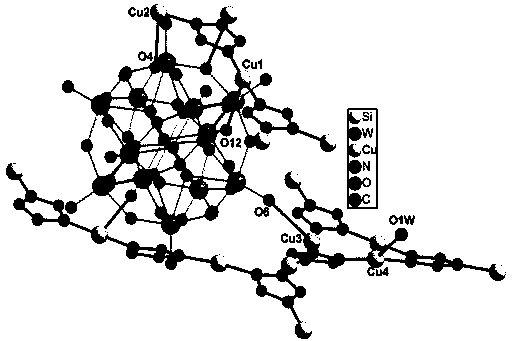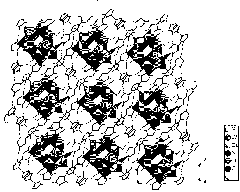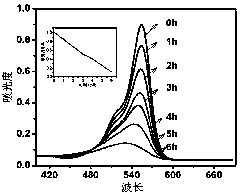Visible-light catalyst for degrading rhodamine B in water and application of catalyst
A catalyst and visible light technology, which is applied in the field of photocatalysis, can solve the problems of large band gap of titanium dioxide, limited photoresponse range, and no realization, and achieve good catalytic effect, good water stability, and simple process.
- Summary
- Abstract
- Description
- Claims
- Application Information
AI Technical Summary
Problems solved by technology
Method used
Image
Examples
Embodiment 1
[0022] A kind of visible light catalyst for degrading rhodamine B in water, chemical formula is [Cu I 12 (1,2,4-Triazole) 8 (H 2 O) 2 ][ α -SiW 12 o 40 ]·2H 2 O, is a metal-organic framework based on polyoxometalates and has a three-dimensional framework structure. There are four crystallographically independent Cu in the compound I ion, through which it interacts with the ligand 1,2,4-triazole (trz) – interconnected to form a two-dimensional bicyclic cationic framework with coexistence of three- and ten-membered rings [Cu I 12 (1,2,4-Triazole) 8 (H 2 O) 2 ] 4+ ,and[ α -SiW 12 o 40 ] 4–The anion interacts with Cu1 on the two-dimensional bicyclic ring through its terminal oxygen atoms (O12, O4, and O6), respectively. I , Cu2 I and Cu3 I The ions are connected to form a three-dimensional framework structure.
[0023] The preparation method of the visible light catalyst for degrading rhodamine B in water is prepared by solvothermal method, and the steps are a...
PUM
| Property | Measurement | Unit |
|---|---|---|
| concentration | aaaaa | aaaaa |
Abstract
Description
Claims
Application Information
 Login to View More
Login to View More - R&D
- Intellectual Property
- Life Sciences
- Materials
- Tech Scout
- Unparalleled Data Quality
- Higher Quality Content
- 60% Fewer Hallucinations
Browse by: Latest US Patents, China's latest patents, Technical Efficacy Thesaurus, Application Domain, Technology Topic, Popular Technical Reports.
© 2025 PatSnap. All rights reserved.Legal|Privacy policy|Modern Slavery Act Transparency Statement|Sitemap|About US| Contact US: help@patsnap.com



